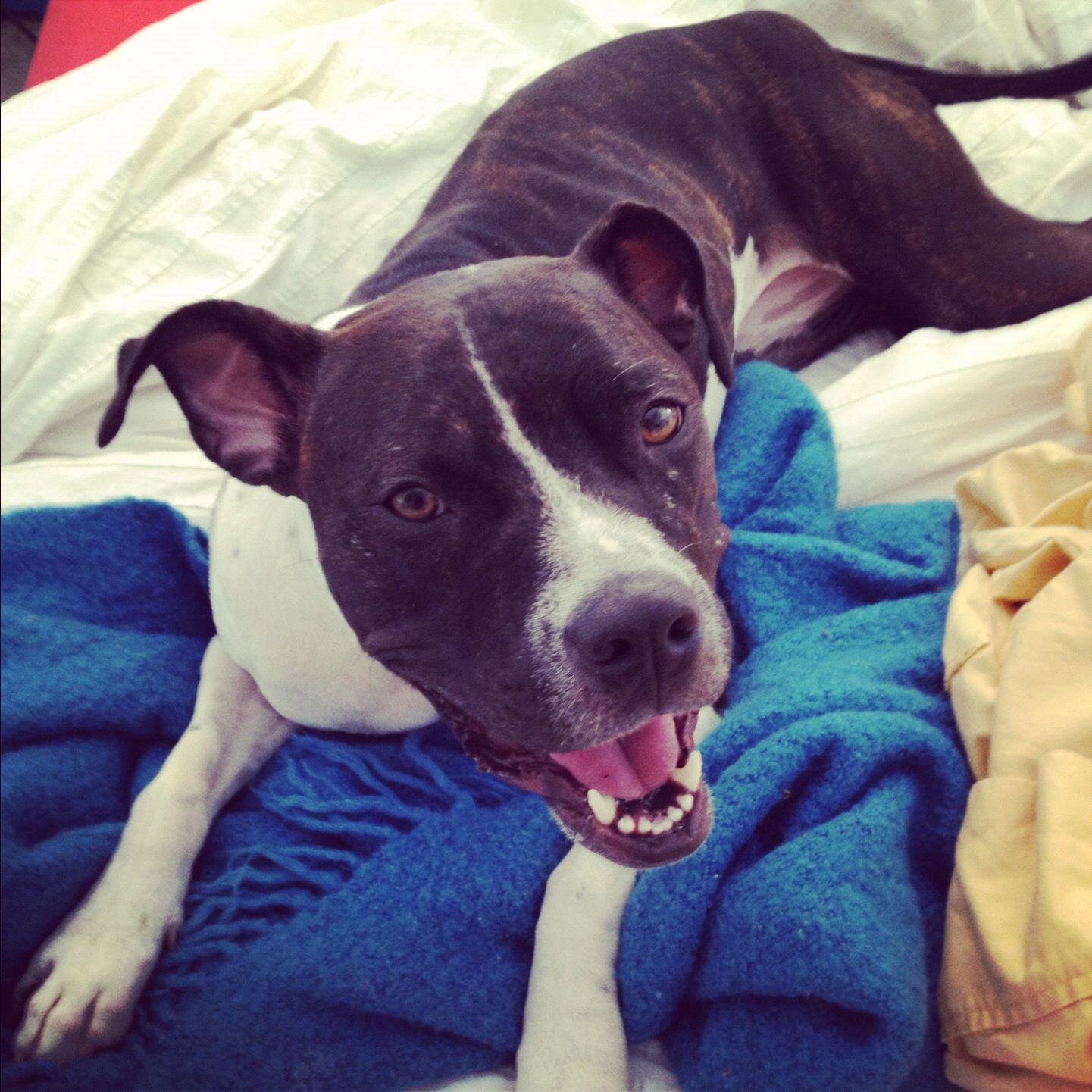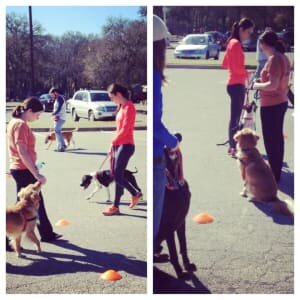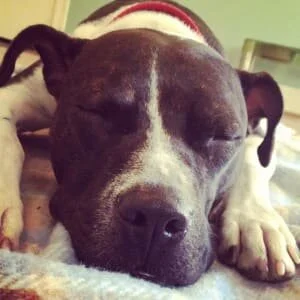Leash Gremlins Need Love Too: Help for Reactive Dogs
Reactivity is one of the single most common behavior issues faced by dogs and their people. In fact, many of us need only glance a few inches down the couch to see our very own much loved leash gremlins. Rather than just define what reactivity is, we wanted to focus on effective support strategies with this post. Before we begin, there are two very big points we'd like to make about so-called reactive dogs:
1. They are good dogs with rich personalities who don't deserve to be defined by a label.
2. Reactivity is a problem that responds well to behavior modification.
Cupcake is serving as the reactivity spokesdog, not because it defines who she is, but because it doesn't. Cupcake is a crazy smart, loving, wiggly, adorable, loyal, energetic girl who loves fetch, learning, napping, cuddling, and adventures. Reactivity is just something this wonderful (exceptional, really) dog has struggled with. In Cupcake's case, her reactivity is tied to an early lack of socialization and a long and stressful shelter stay during adolescence and young adulthood that included some less than positive interactions with other dogs.
Other dogs struggle with reactivity to different things for different reasons. But just like Cupcake, it does not define them and we need to be careful that we don't let it. They are good dogs with their own individual personalities, preferences, favorite toys and activities, and most coveted delicious eatables. There are undoubtably activities at which they can and do excel. Rather than feeling that this single issue means a dog has to spend life in a bubble, we need to identify and take advantage of what these dogs love and do well, while helping to de-escalate their reactivity to, at minimum, a manageable level.
While Cupcake can't write this post herself, we know she'd have a very strong opinion on the notion that leash gremlins need love too. She is, after all, one of the most lovable leash gremlins we've ever had the privilege of knowing…
Helping Reactive Dogs
1. Empathy and Respect
At a wonderful seminar by Suzanne Clothier, she made a point about reactive dogs that stood out very clearly, “Respect what the reactive dog is seeing. S/he is not wrong.” This point holds true on several fronts. First, some reactivity is normal dog reaction misclassified as problem behavior. Clothier illustrates this crucial point in her article, “He Just Wants to Say Hi!” The dog who is responding appropriately to another dog's rudeness is not a dog who is in the wrong.
Second, even if the dog's response is out of proportion for the stimulus, that doesn't mean that it isn't a valid experience for that dog. Cupcake is a perfect example of this. Her reactions typically occur if she perceives the other dog is a threat. It is her lack of social skills that mean she sometimes misreads other dogs or responds too quickly without sufficient avoidance behaviors (though, through training, she has developed a much better skill set). However, dismissing what the dog is seeing does nothing to help the dog. We must respect what they perceive if we are to identify triggers and give them the skills they need to better navigate situations they find stressful.
Finally, the notion of respect extends to the community at-large and the way we treat, handle, and manage the domesticated dog. Contrary to popular opinion, it is not appropriate or safe dog behavior for off-leash dogs to sprint up to a fellow dog walking along on leash. Dogs have a developed etiquette all their own and both humans, and dogs who've had this breach of etiquette reinforced by humans, violate it at potential serious consequence to all involved.
The same goes for humans who pet without asking or lean over the heads of dogs they don't know. It may sound alarmist or harsh, but these scenarios are common set-ups for dog fights, human bite incidents, and lasting set-backs for the dogs who were walking along with their person, minding their own business when they were accosted on the sidewalk or at the park. Dogs in Need of Space has a great set of handouts explaining what appropriate etiquette looks like and why it's so important.
2. Behavior Modification
Working on reactivity can be a very meaningful way to deepen your relationship with your dog and it just so happens there are a TON of great training and behavior modification approaches to help your dog learn to replace disproportionately reactive behavior with socially appropriate behavior. The best and safest training techniques help you take the drama out of the situation for your dog. You learn to read their signals and give them the skillset they need to feel safe and make good choices when confronted with the stimulus.
To effectively work on reactivity with your dog, you need a solid understanding of three things:
-Threshold. This magical little word is used a lot but not always accurately understood. The best explanation we've seen comes from this post by Suzanne Clothier on understanding the stimulus gradient and keeping your dog in the “think and learn zone.” For those who like a visual illustration, Doggie Drawings created a good one:
-Dog Body Language. You can't effectively use threshold if you don't understand how your dog is feeling. Understanding and accurately reading dog body language is a critical missing component from a lot of training. Turid Rugaas' book On Talking Terms with Dogs: Calming Signals is a good place to start, as is Brenda Aloff's Canine Body Language – A Photographic Guide. As for many things dog, Lili Chin of Doggie Drawings offers some adorable illustrated cheat sheets and Tails From the Lab created this excellent series on learning to speak dog.
-Counter Conditioning and Desensitization. How do we change our dog’s emotional and behavioral response to the stimuli they’re reactive to and genuinely teach them that scary, stressful, or frustrating thing isn’t such a big deal? We manage for threshold by ensuring the stimulus isn’t presented at a closer distance, more intense level, or longer duration than our dog can cope with and we consistently pair that stimulus with really good stuff like tasty snacks. This is an excellent and more in-depth overview of how CC&D works. And we happen to have a cute visual for that too:
Now for our favorite techniques, all Cupcake endorsed, for working on dog reactivity. Fun fact? There is no reason that you need to choose just one!
–BAT: Behavior Adjustment Training: This is particularly effective for anxious or fearful dogs and is one of the things that has helped Cupcake the most. Dogs learn socially appropriate behavior including moving away from the trigger to replace the reactive behavior. Often, learning they can just move away rather than engaging, and that their human understands that desire and will go with and encourage them, causes a dog’s confidence to soar.
-Parallel Work: This is simply engaging in activities that the dog enjoys at an appropriate distance from the stimulus and, just like with BAT, working to decrease that threshold while enabling the dog to choose appropriate behaviors and reinforcing those appropriate choices. It can be literally anything from training games, scent work, relaxation protocols and calming touch, a formal group class, or even just a group/buddy walk, hike or doggie picnic. We incorporate parallel work with our reactive dogs regularly because it can be such a positive learning experience in a fun, low-pressure context.
–LAT: Look at That! or Engage/Disengage: This is one that works well for all subsets of reactivity from the fearful dog to the squirrel or bike chaser. It's not just the activity, but the philosophy behind it that we really appreciate. Like the above two activities, the dog is fully aware of the stimulus (be it another dog, etc.) and gets to make a positive choice, while also building a more positive association with the stimulus. If your dog struggles with this, particularly in urban or suburban neighborhoods where it can be more difficult to control for threshold, check out one of our favorite scaffolds and a skill we think every dog should have below…
-Attention Sound: An attention sound is a distinctive sound that we have conditioned to specifically mean disengage from whatever is happening and rapidly orient to your handler – it does not require perfect eye contact, a sit, or any other behavior beyond just that rapid orientation. To teach an attention sound, simply make your chosen sound (we love the kissy noise for this - easy to make for most of us and usually loud and distinctive enough for most dogs) and as soon as your dog orients to you, tell him “Yes! Good boy!” and give him a tasty treat. The rule is your dog gets a food reward every time s/he hears that sound so it becomes highly reliable. You can practice the attention sound indoors, in the yard, and during walks when few or no distractions are around to build fluency.
-Strategic Food Value & Delivery: Like our attention sound scaffold and often paired with it in trickier environments where we need to compensate for closer proximity, longer duration, or a more intense stimulus exposure than we’d ideally like, we can also scaffold our dogs with the value of food we use and our delivery method. Make sure you are using your HIGHEST value food rewards specifically for redirecting attention around any stimuli your pup is reactive to or stressed/overstimulated by – fresh meats and cheeses are often good picks. And rather than delivering the food by hand, try tossing it for your dog to follow. This is often more effective because it is more engaging and fun for the dog, gets their nose to the ground sniffing which lowers heart rate and promotes relaxation, and lets us use our tosses strategically to move the dog where we’d like them to go.
-Pattern Games: Rather than asking a dog to sit in the presence of a stimulus they find overwhelming, we love using Leslie McDevitt's Pattern Games. These keep your dog engaged with and close to you without adding pressure to the situation or asking for more self-control than your dog may have in the moment. Patterned movement is a great way to help a dog take a metaphorical deep breath, continue building a more positive association with a given stimuli, and reinforcing engagement while allowing movement.
-For Dog Reactive Dogs: Positive Social Experiences with Other Dogs: For the sake of safety and the potential to take huge steps backwards in training when something goes wrong, it is important to stress that these experiences are only at the level for which the dog is ready. Otherwise, they are NOT positive social experiences and have the potential to reinforce a negative association with other dogs and increase the reactivity we are trying to deescalate.
For some dogs, this is as simple as the parallel work exercise above. The next step up (and one that often gets skipped) is that same walk or fun, parallel activity with some brief, appropriate greets to say hello, making sure to keep it relaxed and end on a positive note each time. The greetings shouldn't be allowed to go on too long, causing the dog to become uncomfortable or overstimulated and go over threshold. For dogs who are ready, off-leash play dates with appropriate play buddies are great, especially for those dogs whose reactivity is coming from a place of frustration. Again, we just want to make sure that this truly is healthy play.
It should be noted that there are some dogs who may not pass that first level of interaction for quite some time. In some cases, maybe never, or maybe with just one or two trusted canine friends. Please remember that is okay. Sociability is a spectrum and the majority of dogs are not going to be social butterflies with every dog they meet. The world is full of plenty of rich life experiences that don't involve raucous doggie play dates. Not every person wants to go to big parties all the time, and we don't need to expect the equivalent of all dogs. To learn more about dog/dog sociability, go here.
3. Stress Reduction
-When considering contributing factors to any behavior, the first thing to rule out is the medical side of things. Is there a potential medical issue contributing to the reactivity? A consultation with your veterinarian can help ensure you are not unnecessarily fighting an uphill battle by missing out on an underlying medical problem. If your dog is chronically stressed or anxious, you may also want to talk to your vet or a veterinary behaviorist about behavioral medication or supplements.
-Next to consider are your dog's daily routine and potential environmental stressors. Our goal is to remove as many known sources of stress or tension as possible and integrate as many supportive strategies as possible. The easiest way to do this is usually to make a list of the following: What stresses the dog out? What makes the dog happy/best supports their quality of life? Then looking at those lists, what sources of stress are easiest to eliminate or control for and what do we maybe need to discuss from a training/behavior modification standpoint? What supportive strategies can we most easily make part of the routine and what might we want to bring in help for?
-Be aware of trigger stacking and avoid it as much as possible. Trigger stacking refers to a build up of stress from multiple stimuli or experiences a dog finds stressful. The dog may be able to cope with one or even a few of those stressors but as they build up, the dog eventually tips over threshold. On a walk with a reactive dog, this may simply mean that depending on where you are in your dog’s training, they have simply had to pass one too many of their stressful stimuli. We like this analogy from Reactive Champion on the “stress bathtub.”
-If we have fixed all of the basic puzzle pieces, what can we offer the dog to make life less stressful? There are a variety of calming supports that include music, play, touch, scent based enrichment, and supplements. In some cases, medication may be a viable supportive solution.
4. Management
Always remember that it's okay to choose the path of less resistance. In fact, it is probably preferable! We want to prevent our dogs from practicing reactive behavior and the more successful we are at that, the more quickly that reactive behavior will fade and be replaced with the socially appropriate behaviors we’re working to teach. If you know that one neighborhood route takes you past 10 dogs and another takes you past 3 or that changing your walk time by just a bit means you’ll see a more manageable level of stimuli, do it!
Also, remember to use the right tools. A secure harness and a leash that's comfortable to hold can go a long way. Never leave home without your high-value treats and use variety to keep your dog excited to work for them.
What if something still goes awry? It happens to all of us. Walk it off, love your dog, let it go. Teach your dog some emergency skills, and check out this humorous take on the, “Oh crap!” moment we'll all experience at least once.
5. Perspective
You're probably thinking, “Whoa, guys. That is a lot of information.” And you're right, it is. But you don't have to read it all today, or even tomorrow. Take your time and keep your own dog in mind as a filter. Look at your own adorable little gremlin and the focus will probably narrow quite a bit. Need help? Find a local trainer you feel good about and check out our post on finding a smoother training journey.
As you go forward, one of the best things you can do is focus on what you love about your dog and discover things you can do together that you both enjoy. Do not make the reactivity the center of your relationship and remember to always see the dog in front of you. Your dog is not just a leash gremlin. They are a wonderful best friend with thoughts and feelings and goofy expressions and silly habits and the ability to make you smile and teach you valuable lessons about life. And you know what? That reactivity isn't your dog's fault, nor is it something they're doing on purpose.
Need some solidarity? Look for a local reactive dog meet-up group or training class in your area and join the community at Dinos: Dogs in Need of Space. Did you notice Doggie Drawings has a lot of dog behavior illustrations? Go meet Lili Chin's dog Boogie. He has a lot to say.
So what about our girl Cupcake?
We first met Cupcake as an adolescent dog struggling in the shelter environment. The sounds she made on leash inspired us to coin the phrase leash gremlin. She also in all seriousness is one of the most amazing dogs we’ve ever had the pleasure of knowing, loving, working with, and learning from.
Cupcake found her home years ago with her very own momma, Official Lady, and soulhuman who, over time, also snagged Cupcake a daddy and a canine brother named Walrus. Cupcake is a senior now and has been cheering for her fellow gremlins from the comfort of her own home for over 10 (!) years. Opinionated lady that she is, we know she'd send out all the love and solidarity in the world to the dogs and their people following in her paw prints.






